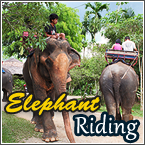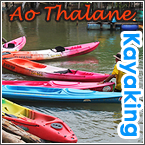The Banana And Its Many Uses
June 2, 2010 by admin
Filed under Living & Lifestyle
Over the years Thais have developed many other useful purposes for different parts of the banana tree.
One choice gift that Mother Nature has created for us is the banana. What the true value of this gift has for us depends, however, on the ways we can find the most uses for it. There are many kinds of bananas in Thailand, with various types flourishing in different environmental conditions. There are wild bananas that prefer narrow valleys in the mountains. These are not widely eaten because the fruit is full of hard seeds, but the leaves are useful. The kluay lep mue nang are a kind of wild banana that grows in rocky crevices where the soil covering is not thick. The fruit are small but compensate for it with their fine fragrance and sweetness, plus they don’t have seeds. The province where they are most common is in Chumphon. Kluay khai, or “egg bananas”, grow best where the temperature is somewhat hot, like in Kamphaeng Phet, for example. They are small and short with a flavour all in their own. Kluay hom grow best in the Central region.
But the most common type – grown in all parts of Thailand – is the kluay nam wa. There are many other varieties, too, but one thing they all have in common is that the fruit and leaves are put to good use. Thailand’s culture finds a myriad of uses for the banana plant and its fruit. Some are connected with religious beliefs, some with the durable materials it supplies, and some with cuisine. One old belief-based custom that has survived till the present has to do with building new houses. Thai tradition requires that a ceremony be performed before the first pillar is set into the ground to bring good fortune. A sugar cane plant and a banana tree are tied to one end of the pillar with multicoloured pieces of cloth. The sweetness of the sugar cane represents happiness and the banana tree, growth. When the ceremony is finished the sugar cane and the banana tree are planted next to the house. So in the future the family who live in it will have sugar cane to eat and the banana tree will keep supplying them with fruit. The materials provided by the banana plant have also been put to use in many ways over the centuries. Every household would probably have at least one banana tree on the property, or at least nearby. If someone was caught in the rain, a banana leaf made for an excellent umbrella, which could simply be discarded when the weather cleared up, and then deteriorate and become a natural fertiliser. The thin membrane on the stem of a banana tree could be torn into strips and then dried under the sun to make an excellent twine. In the past it was moistened before use and the cord it produced was easy to tie and extremely tough. Banana leaves could also be dried and then formed into cups to hold both dry and wet foods.
New leaves that had just opened were used to roll cigarettes, which were very popular years ago. Banana leaves can be used to wrap all kinds of foods. They have long been used by market vendors to wrap, for example, steamed pla thu (mackerel) or fresh chillies before presenting them to a customer. Even now, when vegetables are kept fresh by storing them in a special drawer in the refrigerator, vegetables stay fresher for a long time if they are tightly wrapped first in banana leaf, and then in newspaper. The leaves are also used to wrap certain kinds of foods, and sometimes the association of banana leaves with a particular dish is so strong that it becomes its symbol. Haw mok (fish meat and herbs steamed in a curried coconut custard wrapped in banana leaf) is a good example. If it isn’t steamed in a banana leaf wrapping, the symbolic link is gone. It may not even taste as good as it should.There are many other steamed foods, including kanom kluay, kanom tan, kanom sai sai and khao tom mud that must be wrapped in banana leaf. Some grilled snacks are cooked in banana leaves, too. Among them are kluay ping (sticky rice wrapped in banana leaf, together with sliced bananas), or the same thing made with taro root or beans. One trick for making the chilli dipping sauce nam prik kapi really delicious is to wrap the kapi in banana leaf first, then grill it over a fire until the leaf is scorched. The grilling process brings out the aroma of the kapi, and the nam prik made with it becomes far tastier. As for the banana fruit, it can be eaten either raw or cooked. In the past, when children were getting their first tooth and getting ready to learn how to chew, their mothers would take the fruit of the kluay nam wa and grind it together with rice. The banana helped with the digestion of the rice. Kluay nam wa is used to make a number of desserts, including kluay ping, kanom kluay and kluay buat chee. Even the small, hard, root-like runners that spread the banana tree can be eaten. They are especially good when cooked in gaeng som (a sweet and sour spicy curry made without coconut cream), together with pla chon (snakehead fish). These are only a few examples of dishes made with bananas, mostly the kluay nam wa variety. There is one more kind of banana that shouldn’t be overlooked – the kluay tanee. Some people like to plant several different varieties of banana trees on their property to get many kinds of fruit. Kluay hom can be sold but they take a long time to bear fruit, and the bananas themselves take some time to fully ripen. Kluay nam wa bear fruit that is ready to sell more quickly, and everybody likes them. But one type of banana that will be represented by only a tree or two is the kluay tanee. Its leaves are very tough and hard to tear. The leaves of other varieties will tear when a strong wind blows, but the long leaves of the kluay tanee are much sturdier and they are also coloured a more intense green. They make a first class wrapping material, or kluay bai sri, the funnel-shaped receptacle used for making religious offerings. The fruit is full of hard seeds and difficult to eat, but the flowers are highly esteemed by cooks. As soon as a plant comes into flower the blossom is cut to make gaeng lieng (a vegetable soup-like dish). The pulp of the flower has a delicate texture without coarse fibres, and is white, sweet and crunchy. The ingredients needed to make gaeng lieng include fresh peppercorns, shallots, the aromatic root called krachai, a little kapi and a single dried chilli, all pounded to a fine consistency. Then the meat of a dried fish that has been grilled to crispness is added and pounded together with the other ingredients until they are thoroughly mixed. The kluay tanee flower, cut into fine shreds, is boiled in water to which the paste is also added, plus a little salt, or nam pla, is put in as well. Before the soup is lifted from the fire some fresh bai maeng lak (a type of basil) is added. Gaeng lieng made this way is more delicious than if made with the flower of any other kind of banana. These are just a few of the countless uses the Thai people have found for the banana plant and its fruit. Some types have fruit that is left aside in favour of the highly useful leaves. Others have tasty fruit but leaves for which no purpose has been found. This is another example of Mother Nature presenting us with a balance of useful properties. It has been left to us to find ways in which each type of banana can benefit our lives.
SOURCE : http://bangkokpost.com/leisure/restaurant/37975/the-banana-and-its-many-uses
















